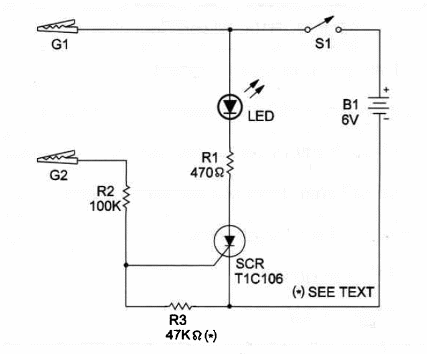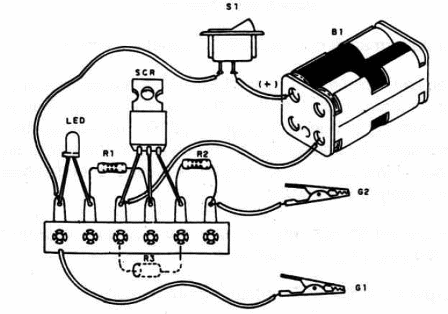This is a one-bit memory that can be used to store a simple bit of information, such as a remote power-failure or closed-trap detector, or a touch sensor.
The circuit operates as follows: When the resistance between the alligator clips falls, the SCR is triggered, powering ON the LED.
The SCR and LED stay in the ON state even after the applied pulse to the input is gone. So the device “memorizes” the event.
The sensor can be a magnetic switch (reed switch), a microswitch, or a touch switch.
A simple touch switch is a metal plate wired to G2.
To get best sensitivity, G1 needs a good ground. You can also use as sensor two metal plates that are touched at the same time to trigger the circuit ON.
The circuit is powered by four AA cells and current drain is very low when the LED is off. When the LED is on, current drain is less than 10 mA.
To reset the device you only have to toggle S1.
Another way to reset the circuit is to wire a momentary switch between the anode and cathode of the SCR.
Sensors can be wired to the device with long unshielded wires.
The schematic of the One-Event is shown in Figure 1.

Though R2 and R3 are shown as fixed, you can use a 1,000,000 ohm potentiometer if you prefer.
A sensitivity adjustment will get better performance from the register.
Figure 2 shows the One-event Register, on terminal strip mounting.

As it is an experimental circuit you can also use a solderless board to install the components.
The circuit can easily be housed into a small plastic box.
Observe the positions of all the polarized components, such as the LED, SCR and power supply.
Resistor R3 is only necessary if TIC106 is used. Other SCRs, such as the MCR106 and C106, don’t require R3.
One-Event Register
SCR - TIC106 or MCR106 Silicon Controlled Rectifier
LEDs - Red, yellow or green common
R1 - 470 ohm, ¼ W, 5% resistor
R2 - 100,000 ohm, ¼ W, 5% resistor
R3 - 47,000 ohm, ¼ W, 5% resistor - see text
S1 - SPST slide or toggle switch
B1 - 6 V - four AA cells
G1, 2 - Alligator clips
Ideas to Explore
To get better performance or to learn more about the circuit:
You can replace R1 and the LED with a buzzer or audio oscillator to get an alarm. But, remember that there a voltage drop of about 2 volts when current flows through the SCFt. This voltage drop can be compensated by adding two or three volts to the power supply. For instance, if you use a 6-volt relay, the recommended voltage for the power supply is 8 or 9 volts.
As current drain is very low when the LED is off, depending on the intended use, Si can be removed.
Explain how the SCR operates in this circuit.
Science and uncommon applications:
You can connect an LDR between G1 and 62 for a light-operated one-event memory or alarm. A single short pulse of light can trigger the circuit.
Use this circuit to know when someone touches an object when you leave it unattended. You can also know it someone entered your room when you were out.
By using two bare wire as sensors, you have a water-level alarm. The LED will glow when the water touches the two bare wires at the same time.




